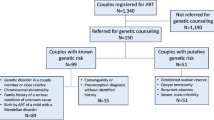Abstract
Objective
Medical malpractice claims vary by specialty. Contributory factors to malpractice in reproductive endocrinology and infertility (REI) are not well defined. We sought to determine claims’ frequency, basis of claims, and outcomes of settled claims in REI.
Design
This is a retrospective, descriptive review of 10 years of claims.
Setting
The setting is private practices.
Materials and methods
Claims were monitored within one malpractice carrier between 2006 and 2015 covering 10 practices and 184,015 IVF cycles. Total claims, basis of claims, and indemnity paid were evaluated.
Results
There were 176 incidents resulting in 30 settled claims with indemnity payments in 21. Categories of claims settled included misdiagnosis (N = 4), lack of informed consent (N = 5), embryology errors (N = 8), and surgical complications (N = 4). Total and average awards were $15,062,000 and $717,238, respectively. Misdiagnosis and lack of informed consent had highest total award amount at $11,583,000 accounting for 76% of award dollars. The two highest awards were $4.5 million and $3.0 million for cancer and genetic misdiagnosis, respectively. Excluding these two awards, payments totaled $7,562,000, ranged from $6000 to $900,000 and averaged $170,363. Errors in handling of embryos were highest in frequency accounting for 38% of claims paid for a total of $1,593,000 with average payment of $199,188. Settlements for surgical complications totaled $1,855,000 and averaged $463,750 per claim.
Conclusions
Misdiagnosis and lack of informed consent are the highest award categories. Embryology lab errors are the most frequent causes of claims with the lowest award per settlement. The average cost for claims settled is relatively high compared to settlements in other specialties.

Similar content being viewed by others
References
Mac Court D, Bernstein J. Medical error reduction and tort reform through persistent controllably level quality medicine societies. Am J Law Med. 2009;35:505–61.
Kravitz RL, Rolpf JE, McGuigan K. Malpractice claims data as a quality improvement tool: epidemiology of error in for specialties. JAMA. 1991;266:2087–9.
Van Noord I, Eikens MP, Hanersma AM, Bruijne MC. Application of root cause analysis on malpractice claim files related to diagnostic failures. Qual Saf Health Care. 2010;19(6):e21.
Spittel MJ, Bismark MM, Studdert DM. The PRONE score: an algorithm for predicting doctors risks of formal patient complaints using routinely collected administrative data. BMJ Qual Saf. 2015;24:360–8.
Sohn D. Negligence, genuine error and litigation. Int J Gen Med. 2013;6:649–56.
Stamm JA, Korzick KA, Beech K, Wood KE. Medical malpractice: reform for today’s patients and clinicians. Am J Med. 2016;129(1):20–5.
Latino RJ. How is the effectiveness of root cause analysis measured in healthcare? J Health Risk Manag. 2015;35(2):21–30.
Khorsandi M, Beatson K, Alijani A. Quality review of an adverse incident reporting system and root cause analysis of serious adverse surgical incidents in a teaching hospital of Scotland. Patient Saf Surg. 2012;6:21. doi:10.1186/1754-9493-6-21. Published online 2012 Aug 29.
Heideveld-Chevalking AJ, Calsbeek H, Damen J, Gooszen H, Wolff AP. The impact of a standardized incident reporting system in the perioperative setting: a single center experience on 2,563 ‘near-misses’ and adverse events. Patient Saf Surg. 2014;8(1):46.
Warm D, Edwards P. Classifying health information technology patient safety related incidents—an approach used in Wales. Appl Clin Inform. 2012;3(2):248–57. doi:10.4338/ACI-2012-03-RA-0010.
Institute of Medicine. In: Kohn LT, Corrigan JM, Donaldson MS, editors. To err is human: building a safer health system. Washington, DC: National Academy Press; 1999.
Wachter RM, Pronovost PJ, Shekelle PG. Strategies to improve patient safety: the evidence base matures. Ann Intern Med. 2013;158(5):350–52, part 2, Editorial, W-173. Posted on RAND.org on March 01, 2013.
Graber ML. The incidence of diagnostic error in medicine. BMJ Qual Saf. 2013;22 Suppl 2:ii21–7. doi:10.1136/bmjqs-2012-001615.
Crockin SL. Reproduction, genetics and the law. Reprod BioMed Online. 2005;10(6):692–704.
Amagwula T, Chang PL, Hossain A, Tyner J, Rivers AL, Phelps JY. Preimplantation genetic diagnosis: a systematic review of litigation in the face of new technology. Fertil Steril. 2012;98:1277–82.
Wilton L, Thornhill A, Traeger-Synodinos J, Sermon KD, Harper JC. The causes of misdiagnosis and adverse outcomes in PGD. Hum Reprod. 2009;1:1–8.
Lee H, Mathews SC, Shore A, Makary MA, Pronovost PJ, Newman-Toker DE. 25-Year summary of US malpractice claims for diagnostic errors 1986–2010: an analysis from the National Practitioner Data Bank. BMJ Qual Saf. 2013;22(8):672–80. doi:10.1136/bmjqs-2012-001550.
Studdard DM, Mello MM, Gawande AA, et al. Claims errors and compensation payments in medical malpractice litigation. NEJM. 2006;354:2024–33.
Brennan T, Sox CM, Burstin HR. Relation between negligent adverse events in the outcomes of medical malpractice litigation. NEJM. 1996;335:1963–7.
Acknowledgements
The author declares no financial support from any sources.
Author information
Authors and Affiliations
Corresponding author
Ethics declarations
Conflict of interest
The author declares that he has no conflict of interest.
Rights and permissions
About this article
Cite this article
Letterie, G. Outcomes of medical malpractice claims in assisted reproductive technology over a 10-year period from a single carrier. J Assist Reprod Genet 34, 459–463 (2017). https://doi.org/10.1007/s10815-017-0889-3
Received:
Accepted:
Published:
Issue Date:
DOI: https://doi.org/10.1007/s10815-017-0889-3



